My single line text
My single line text
My single line text

BEYOND THE GARDEN GATE
ARTSHOPPING 2018 Salon International d'Art Contemporain
Paris, Carrousel du Louvre Mai 25th - 27th, 2018
April 27th, 2018

Andrea Fallini
“BEYOND THE GARDEN GATE”, the new show proposed by B.Zanconato at Carrousel du Louvre in Paris, during the ArtShopping 2018 spring edition, represents a sort of summary of the speech developed by the artist with her recent exhibitions, in particular “Teshuvà” and “Der Suchende”. After having highlighted some of the contradictions that characterize the contemporary society, after having shown how the appearance represents the essence of many matters, the artist turn her sight further, beyond the boundary of the common view of the world……
“Beyond the garden gate”, the first work of the new narration, gives the title of the show and also gives a key to its interpretation. The artwork is composed by two main elements, in tension between them : the first, a residue of a door or a gate, holds up other elements like a broken mirror and two No Entry signs. The second one consists of a multicolour chair, covered by graphic characters and writings.
Everything, as always in the case of the B.Zanconato’ s artistic production, is symbolic. From one side, the barrier, represented by the door that, redundantly, holds up the No Entry signs.
In reality, what it’s presented to us is not a barrier but an invitation to come in (or to come out): in fact, the door and the signs present evident marks of the time and of its consequences to highlight a past and out-dated situation, to be crossed. And struck chains rest on the door, as a sign of a newly acquired freedom.
Everything, as always in the case of the B.Zanconato’ s artistic production, is symbolic. From one side, the barrier, represented by the door that, redundantly, holds up the No Entry signs.
In reality, what it’s presented to us is not a barrier but an invitation to come in (or to come out): in fact, the door and the signs present evident marks of the time and of its consequences to highlight a past and out-dated situation, to be crossed. And struck chains rest on the door, as a sign of a newly acquired freedom.
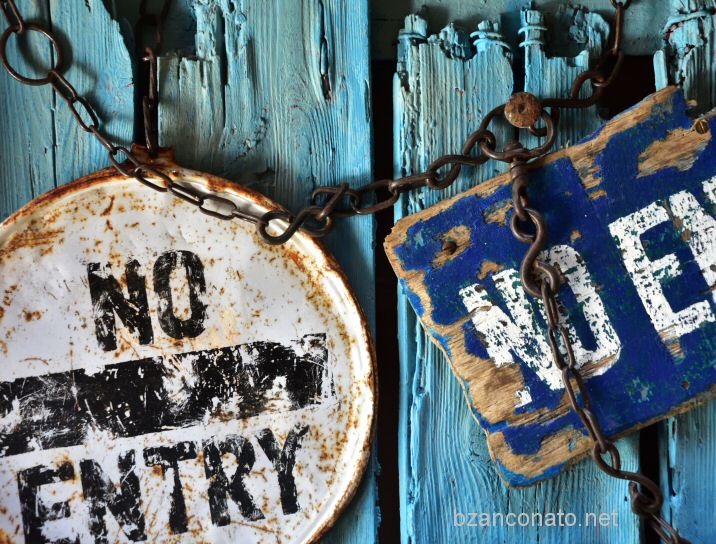
On the other hand, the chair, symbol of immobility if not of comfort, representation of a convenient situation, of a deadlock obtained inside of a fence of taken certitudes and never called into question (emblematic, in this regard, one of the writings on the seat that says in Italian: “We build up window guards around a poor and arid fulcrum, while out there, around them and against them our irrational movements get upset but we don’t give them right of access”).
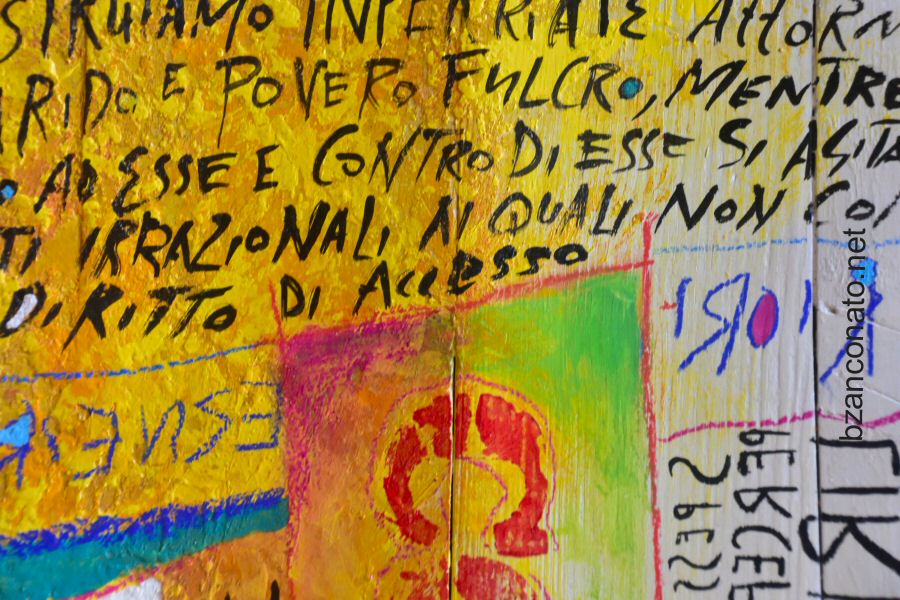
It’s easy to observe that the work is suitable for different levels of interpretation that you could link, from one side, to the international geopolitical situation, in which the barriers, also the customs barriers, strongly seem to return of current interest. Moreover, time changes things and the situations so, faced with moments of deep change like the ones we are living, you have to open the horizon and to overcome the “same old prescription”.
To the other side, the artwork also symbolises the dilemma regarding each single person, dealing with multiple changes of the daily life, that become necessary at all levels. And this landmark requires a complete re-analysis, if not a complete revision, of the contemporary life paradigms and of the founding values.
This is the invitation of the artist: that is don’t be afraid to go looking for a new solution to problems and difficulty of today’s life; don’t be afraid to change or subvert old visions, that, looking at the changes taking places, are unsuitable and passed. So, a call to avoid fixed, traditional and comfortable positions.
“Beyond the garden gate” refers to a small sculpture with a powerful emotional impact: “Roots”.
“Roots” deals with a subject extremely important to the artist: that is the familiar imprinting and the infancy upbringing, the constraints given by the traditions and familiar bonds.
To the other side, the artwork also symbolises the dilemma regarding each single person, dealing with multiple changes of the daily life, that become necessary at all levels. And this landmark requires a complete re-analysis, if not a complete revision, of the contemporary life paradigms and of the founding values.
This is the invitation of the artist: that is don’t be afraid to go looking for a new solution to problems and difficulty of today’s life; don’t be afraid to change or subvert old visions, that, looking at the changes taking places, are unsuitable and passed. So, a call to avoid fixed, traditional and comfortable positions.
“Beyond the garden gate” refers to a small sculpture with a powerful emotional impact: “Roots”.
“Roots” deals with a subject extremely important to the artist: that is the familiar imprinting and the infancy upbringing, the constraints given by the traditions and familiar bonds.
The symbolism here develops by a multiplicity of perspectives and meanings. But, without going into any detail of the specific interpretation of the sculpture, the main question posed by the artist is about the deep meaning of the education and of the one’s nearest and dearest.
In fact, are we talking about to teach the respect for the rules and norms having the main goal to uniform the child to familiar and social judgements, eventually blocking and deviating the character and the predispositions (if not crushing the self-esteem), or, on the contrary, to try to identify and then develop his characterizing aspects, his predispositions, his diversity and uniqueness?
Of course, this second possibility results less comfortable, more expensive in terms of energies and attentions, but doesn’t it lay the foundations for full and strong development of the future adult personality and also more enriching to whom that follows gradually the growth? This would be a way to cultivate new generations by giving them a solid foundation for the development of a strong autonomy and an example of openness and promotion of diversity without preconceived schemes, often forced by legacy of past, today no longer current, isn’t it?
In fact, are we talking about to teach the respect for the rules and norms having the main goal to uniform the child to familiar and social judgements, eventually blocking and deviating the character and the predispositions (if not crushing the self-esteem), or, on the contrary, to try to identify and then develop his characterizing aspects, his predispositions, his diversity and uniqueness?
Of course, this second possibility results less comfortable, more expensive in terms of energies and attentions, but doesn’t it lay the foundations for full and strong development of the future adult personality and also more enriching to whom that follows gradually the growth? This would be a way to cultivate new generations by giving them a solid foundation for the development of a strong autonomy and an example of openness and promotion of diversity without preconceived schemes, often forced by legacy of past, today no longer current, isn’t it?

Obligation and the schematization within previously established models represents the central theme of another work on display: “WHAT’S YOUR NUMBER?” a kind of wall sculpture, a filing cabinet in which many different numbers are inside cells.
Among them, some "prime numbers", are confined within genuine cages. On the sides of the artwork the provocative question "What's your number?"
If “Roots” gives a look at the relationships that the individual, in his early years, sets out with the first social circles with which he comes into contact, family and then school, “WHAT’S YOUR NUMBER” addresses the topic of difficult, often confrontational, relationship individual-society: on the one hand, how the society tries to reduce the single to a number, to an abstract and depersonalised entity to handle and frame, so that the same algorithm applies to everyone, so that statistics are more easily filled and data more smoothly collected. And, on the other hand, how the individual is living framed in a box, within private and vital space in which to express his true personality but that becomes increasingly small and tight. Some, perhaps many, does not found him-self in this depersonalizing system and, as the primes numbers of the representation by the artist, they feel caged.
Among them, some "prime numbers", are confined within genuine cages. On the sides of the artwork the provocative question "What's your number?"
If “Roots” gives a look at the relationships that the individual, in his early years, sets out with the first social circles with which he comes into contact, family and then school, “WHAT’S YOUR NUMBER” addresses the topic of difficult, often confrontational, relationship individual-society: on the one hand, how the society tries to reduce the single to a number, to an abstract and depersonalised entity to handle and frame, so that the same algorithm applies to everyone, so that statistics are more easily filled and data more smoothly collected. And, on the other hand, how the individual is living framed in a box, within private and vital space in which to express his true personality but that becomes increasingly small and tight. Some, perhaps many, does not found him-self in this depersonalizing system and, as the primes numbers of the representation by the artist, they feel caged.
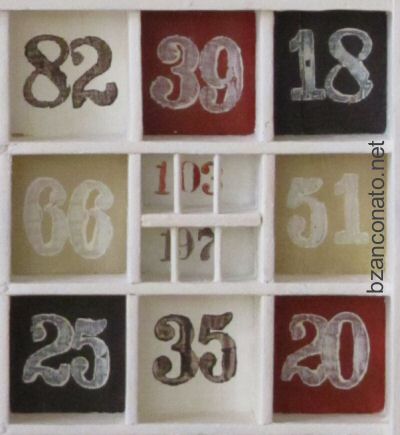
“SIAMO SOLO NOI”, (it’s just us), is impersonating the cry of loneliness of these "prime numbers" created by the expressive form typical of urban rebellion: the graffiti. And in fact, the writer’s act gives perfectly the need for affirmation of individuality, of affirming diversity (such as that of the primes numbers, in fact) in a world that tends to homologate everyone and everything.
“WHAT’S YOUR NUMBER” and “SIAMO SOLO NOI” are artworks that pose the question about the meaning of social life, if, that is, the purpose of the society should be to unify the thinking and acting of the individual or if, otherwise, should be the society and social structures to evolve, to adapt and get to servicing the needs of the individual components, enhancing the diversity and plurality to allow their realization?
“WHAT’S YOUR NUMBER” and “SIAMO SOLO NOI” are artworks that pose the question about the meaning of social life, if, that is, the purpose of the society should be to unify the thinking and acting of the individual or if, otherwise, should be the society and social structures to evolve, to adapt and get to servicing the needs of the individual components, enhancing the diversity and plurality to allow their realization?
And this find a reference in another work on display: “NONSENSE”. If in "WHAT'S YOUR NUMBER?" the prevailing point of view is that of society which tends to clear the differences between people to reduce them to pure elements on which operate algebraic treatments of unification and approval, except to isolate the reluctant and refractory elements, in "NONSENSE", as in "SIAMO SOLO NOI", the viewpoint is that of the individual who, seeing his life channeled into a rut already traced, ask himself the painful question of the meaning of being.
“But – says B.Zanconato - if the mentality and education in the family and in society, they tip over the perspective and if diversity becomes a value instead of a limit, if the different skills and predispositions of individuals are encouraged from an early age and left free to develop and succeed, if the (social) environment is fertile and ready to accommodate the new, if there are no unnecessary bureaucratic obstacles to hinder and obstruct the resourcefulness and human creativity, here, then, the question of the meaning of things, of his existence, would acquire a completely different significance. Basically, what we see depends on lenses we wear (or that we were made to wear)”.
“But – says B.Zanconato - if the mentality and education in the family and in society, they tip over the perspective and if diversity becomes a value instead of a limit, if the different skills and predispositions of individuals are encouraged from an early age and left free to develop and succeed, if the (social) environment is fertile and ready to accommodate the new, if there are no unnecessary bureaucratic obstacles to hinder and obstruct the resourcefulness and human creativity, here, then, the question of the meaning of things, of his existence, would acquire a completely different significance. Basically, what we see depends on lenses we wear (or that we were made to wear)”.

And the artwork entitled “DEPENDE” (it depends on) gives perfectly, in an artistic way, the concept just explained: a ready-made on which, with meticulous pictorial interventions, B.Zanconato represented and gave the complete change of perspective and of scenario depending on the observation point.
Another work, entitled “ARE yOu H@PpY?” provocatively lying on the floor of the exhibition, a sort of doormat to trample on, poses an uncomfortable question: are you happy?
"Everyone talks about happiness. Listening to advertising, the purchase of this of that product will give you happiness. Is part of the collective imagination the fact that happiness is connected to the attainment of a certain economic and social level. Even the new indicators that will replace the GDP of States will take into account the "average happiness" (as if it could be measured, when already define it is a problem!). Yet, perhaps, it might be enough watching people, their expressions, in the morning, awaiting the arrival of the subway in one of Europe's great cities, to see that many of them are not happy despite the nice clothes, good job and, as a result, good income and standard of living. But, perhaps, their life is too frenetic, too fast and full of appointments to find the time to ask yourself this question ... Quickly walking to arrive on time staring at the ground: that's why I placed "ARE yOu H@PpY?" on the floor. I would like to try, at least for a moment, to stop their frenetic and incessant pace and bring them to reflect on themselves. "
Another work, entitled “ARE yOu H@PpY?” provocatively lying on the floor of the exhibition, a sort of doormat to trample on, poses an uncomfortable question: are you happy?
"Everyone talks about happiness. Listening to advertising, the purchase of this of that product will give you happiness. Is part of the collective imagination the fact that happiness is connected to the attainment of a certain economic and social level. Even the new indicators that will replace the GDP of States will take into account the "average happiness" (as if it could be measured, when already define it is a problem!). Yet, perhaps, it might be enough watching people, their expressions, in the morning, awaiting the arrival of the subway in one of Europe's great cities, to see that many of them are not happy despite the nice clothes, good job and, as a result, good income and standard of living. But, perhaps, their life is too frenetic, too fast and full of appointments to find the time to ask yourself this question ... Quickly walking to arrive on time staring at the ground: that's why I placed "ARE yOu H@PpY?" on the floor. I would like to try, at least for a moment, to stop their frenetic and incessant pace and bring them to reflect on themselves. "
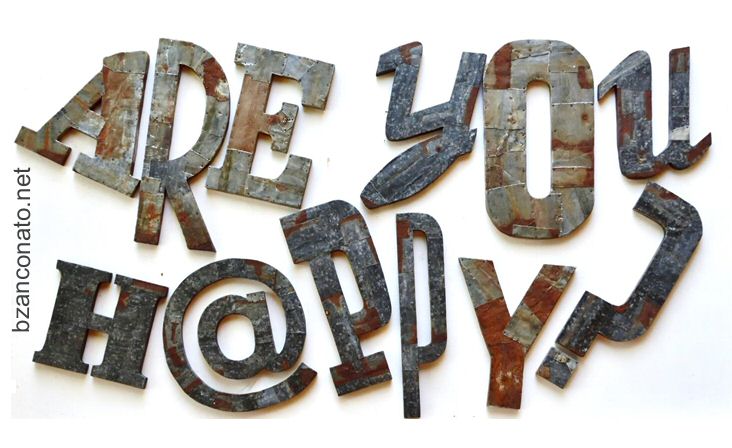
The artist's words lead to another artwork presented at the Corrousel du Louvre: “takE YOuR TimE”,, an invitation to reserve time to ourselves, to take a break from the hustle and bustle of daily run to stop listening to the voices troubling and screaming in the depths of our being. This is certainly an important gesture: ask questions about life things to find our own answer.
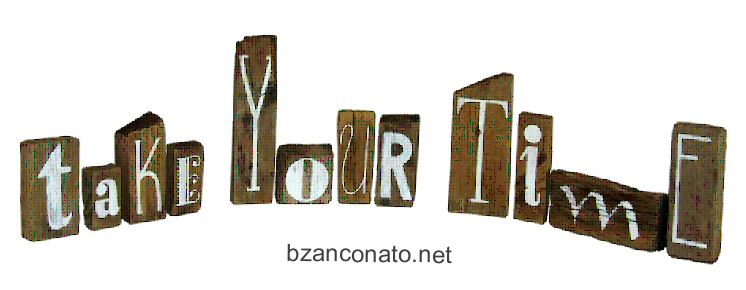
After all, if we agree to take care of our physical health and our body, spending part of our precious time at the gym or running in the park, why not take care of our inner well-being, our spirit, devoting a little time to recognize and give vent to our deepest feelings? to reflect on our attitudes and our values? to perceive what stirs in us in front of problems of the contemporary life? to assess and decide what we really want? to give a meaning to things?
The themes of "ARE yOu H@PpY?" and "takE YOuR TimE" open up different ideas that are found in other works on display. “BLA BLA BLA” (it’s an Italian onomatopoeic expression to say that it’s just words, chatter) addresses the issue of communication in the public sphere, of that sort of bombing of promises (more or less implied) to which we are subject on several fronts of our daily lives.
Starting with the marketing and advertising which, as mentioned, offer the happiness in exchange for the purchase of that item or product; to continue with the politics, which has institutionalized the empty promise, to which usually follows a series of linguistic acrobatics aimed to show its coherence (theoretical).
Starting with the marketing and advertising which, as mentioned, offer the happiness in exchange for the purchase of that item or product; to continue with the politics, which has institutionalized the empty promise, to which usually follows a series of linguistic acrobatics aimed to show its coherence (theoretical).

“BLA BLA BLA” is the representation of the loss of meaning of many speeches, if not much of everyday language, in which the aesthetics of the expression always has the upper hand on the content. In this way the dialectic confrontation, which may have the aim of improving the initial positions of the two sides, becomes a collision of oratory with the obvious aim of prevalence on the opponent. A world where the word has taken such a distance from its meaning to have lost its sense for having acquired a new one, often instrumental. For this reason we are immersed in a world of gossip (hence the onomatopoeic title of the work).
The way forward suggested by artist: having our own opinion, our own idea of things; learn to weigh the words in the light of the facts; discriminate what is pure dialectical exercise from what is relevant and dense of thickness. And for that, our own reflection (see "takE YOuR TimE") is fundamental: it’s us and our consciousness the sieve that discriminates and gives a different value to words, to things, to people.
The way forward suggested by artist: having our own opinion, our own idea of things; learn to weigh the words in the light of the facts; discriminate what is pure dialectical exercise from what is relevant and dense of thickness. And for that, our own reflection (see "takE YOuR TimE") is fundamental: it’s us and our consciousness the sieve that discriminates and gives a different value to words, to things, to people.
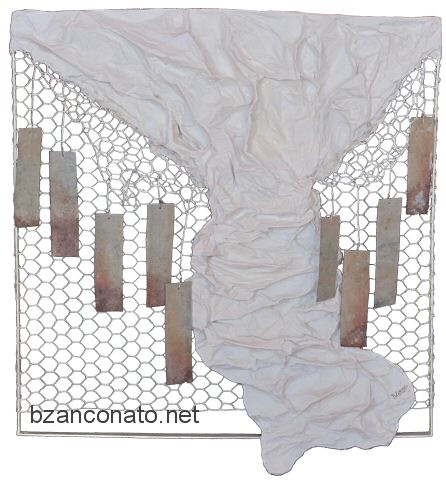
"takE YOuR TimE" also opens another perspective: that of the importance of perceiving and listen to our feelings, to feel and reflect our deeper aspirations and inclinations and use them as a yardstick and sieve of the world. Because, however, these motions, these voices that stir deep in, sooner or later, one way or another, find their way to gush, maybe at unexpected times and in unexpected ways.
This is the subject of another artwork on display: ”ERUPTION”. It is an intimate work that represents the unstoppable advancement of that feeling of surrender, of deep defeat who feels who realizes, suddenly, he has not lived his own life, i.e. not having chased his deepest aspirations, caged and sacrificed to something that, in the end, has proved to be disappointing, unfulfilled ... and taking up the theme of "ARE yOu H@PpY?", for not having achieved that happiness promised as included with the type of life that society and media advertised: always on the run without a true reason, without a moment of pause to evaluate if that's what he really wants.
This is the subject of another artwork on display: ”ERUPTION”. It is an intimate work that represents the unstoppable advancement of that feeling of surrender, of deep defeat who feels who realizes, suddenly, he has not lived his own life, i.e. not having chased his deepest aspirations, caged and sacrificed to something that, in the end, has proved to be disappointing, unfulfilled ... and taking up the theme of "ARE yOu H@PpY?", for not having achieved that happiness promised as included with the type of life that society and media advertised: always on the run without a true reason, without a moment of pause to evaluate if that's what he really wants.
The warning of "ERUPTION" finds its conclusion in the central work of the exhibition: “ETHOS ANTHROPOI DAIMON”. The title takes up one of the cryptic phrases of Heraclitus which in substance can be made in the motto "character is man's fate", meaning character (ethos), the system, conscious or unconscious, of values, beliefs, ideas about himself and the reality, and with destiny (daimon) the purpose, the vocation to which one is born. In the Greek world, in fact (see for example the myth of Er), it was a widespread belief that man spends his life necessarily directed towards what is brought, towards what is voted. To take him (to his fate) is the daimon, his demon, that is in other words, a component of his being that always had clear the man's character, indelibly marked in everyone.

And this is exactly the B.Zanconato’s message with “ETHOS ANTHROPOI DAIMON”. Our existence has a purpose, a reason of being: to fulfill our character, that is our vocation and our predispositions. For the artist the happiness consists in this: to achieve the pursuit of our own capacities and vocations, maybe, leaving a trace of our passage. This type of message is not new. Greek culture embraced this same concept (the word itself happiness, in Greek eudaimonia, is formed from the root eu, which means good, and from daimon, destiny/demon).
However, today this message, beyond the proclamations and empty phrases, goes strongly against the current. In fact, the prevailing materialism and economic-financial vision, which has penetrated the ganglia of society and human behavior, leads to evaluate every action with criteria of convenience, return on investment, pay and profitability and does not include the possibility that the choices, decisions can be taken on the basis of personal criteria, related to the different character.
On the contrary, personal choices and decisions, to ensure the best performance, should not rely on an inner analysis (that is a careful soul-searching) aimed at identifying our own vocation but must be taken on the basis of a in-depth analysis of external conditions (market analysis) in order to locate the position and the best strategy: as if we were making a new product launch.
“But we, - says B.Zanconato in conclusion - what we want to be? Want we to be yet another new product to be exposed on the shelves of the global supermarket which became our contemporary society, which swallows everything and everyone, exactly because everything can become a market item, or will we give meaning to our lives, recognize and develop our predispositions and affirm our uniqueness? This is, for me, the real question to which all of us are asked to answer because every single response has an impact on the lives of the others and, in general, on the society ... "
However, today this message, beyond the proclamations and empty phrases, goes strongly against the current. In fact, the prevailing materialism and economic-financial vision, which has penetrated the ganglia of society and human behavior, leads to evaluate every action with criteria of convenience, return on investment, pay and profitability and does not include the possibility that the choices, decisions can be taken on the basis of personal criteria, related to the different character.
On the contrary, personal choices and decisions, to ensure the best performance, should not rely on an inner analysis (that is a careful soul-searching) aimed at identifying our own vocation but must be taken on the basis of a in-depth analysis of external conditions (market analysis) in order to locate the position and the best strategy: as if we were making a new product launch.
“But we, - says B.Zanconato in conclusion - what we want to be? Want we to be yet another new product to be exposed on the shelves of the global supermarket which became our contemporary society, which swallows everything and everyone, exactly because everything can become a market item, or will we give meaning to our lives, recognize and develop our predispositions and affirm our uniqueness? This is, for me, the real question to which all of us are asked to answer because every single response has an impact on the lives of the others and, in general, on the society ... "
